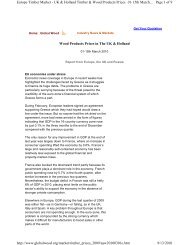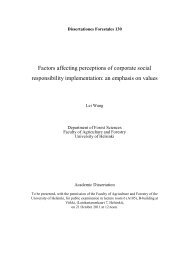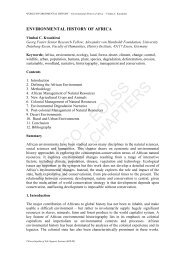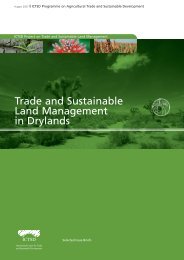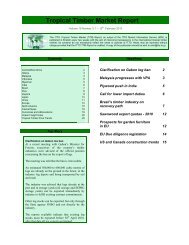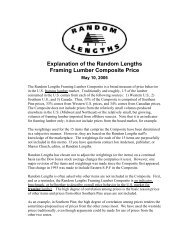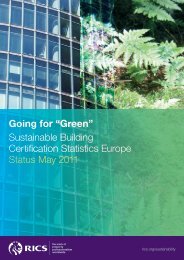ICT and e-Business in the Pulp, Paper and Paper ... - empirica
ICT and e-Business in the Pulp, Paper and Paper ... - empirica
ICT and e-Business in the Pulp, Paper and Paper ... - empirica
You also want an ePaper? Increase the reach of your titles
YUMPU automatically turns print PDFs into web optimized ePapers that Google loves.
<strong>Pulp</strong>, paper <strong>and</strong> paper products<br />
A more conservative scenario is that total dem<strong>and</strong> <strong>in</strong> Europe will cont<strong>in</strong>ue to <strong>in</strong>crease at a<br />
moderate growth rate, but that <strong>the</strong> type of paper dem<strong>and</strong> may change. On <strong>the</strong> one h<strong>and</strong>,<br />
<strong>the</strong>re will be an <strong>in</strong>creased dem<strong>and</strong> for better quality paper; on <strong>the</strong> o<strong>the</strong>r h<strong>and</strong>,<br />
environmental concerns <strong>and</strong> awareness may also drive recycl<strong>in</strong>g <strong>and</strong> <strong>the</strong> use of<br />
recovered paper. If this is <strong>the</strong> case, paper makers will have to position <strong>the</strong>mselves even<br />
more than today as producers ei<strong>the</strong>r of high quality or recycled material. To what extent<br />
<strong>the</strong>se two requirements can possibly be comb<strong>in</strong>ed by means of modern production<br />
technology rema<strong>in</strong>s to be seen.<br />
On a global scale, world markets for paper <strong>and</strong> paper products will certa<strong>in</strong>ly cont<strong>in</strong>ue to<br />
grow fast, <strong>and</strong> particularly <strong>in</strong> Asia <strong>and</strong> South America. While local supply will be available<br />
for bulk products, <strong>the</strong> growth <strong>in</strong> <strong>the</strong>se countries should never<strong>the</strong>less cont<strong>in</strong>ue to be an<br />
<strong>in</strong>terest<strong>in</strong>g market opportunity for producers <strong>in</strong> <strong>the</strong> EU. However, <strong>the</strong>ir competitive<br />
advantage derived from capabilities of high quality production is gradually erod<strong>in</strong>g, as <strong>the</strong><br />
producers <strong>in</strong> emerg<strong>in</strong>g economies are learn<strong>in</strong>g fast <strong>and</strong> modernis<strong>in</strong>g <strong>the</strong>ir facilities.<br />
4.4.3 Summary <strong>and</strong> conclusions<br />
In 2004, <strong>the</strong> paper <strong>in</strong>dustry <strong>in</strong> European countries represented by CEPI 113 produced an<br />
output of about 100 million tonnes of paper <strong>and</strong> about 43 million tonnes of pulp.<br />
Production of paper <strong>and</strong> board <strong>in</strong>creased by 4.5%, <strong>and</strong> dem<strong>and</strong> grew by 2.4%. Thus,<br />
growth <strong>in</strong> production was higher than <strong>in</strong> <strong>the</strong> countries of major competitors (see Section<br />
2.2.1).<br />
However, it is frequently assumed that <strong>the</strong> fast adoption of <strong>ICT</strong> by households <strong>and</strong><br />
bus<strong>in</strong>esses could lead to substitution of paper or paper-based products <strong>in</strong> some<br />
areas <strong>in</strong> <strong>the</strong> future. Important factors that could decrease <strong>the</strong> dem<strong>and</strong> for paper <strong>in</strong>clude<br />
<strong>the</strong> substitution of classified advertis<strong>in</strong>g <strong>in</strong> newspapers by onl<strong>in</strong>e services, <strong>the</strong> general<br />
decl<strong>in</strong>e of <strong>the</strong> traditional newspaper <strong>in</strong>dustry <strong>in</strong> advanced economies, <strong>and</strong> <strong>the</strong><br />
replacement of formerly paper-based media products (e.g. encyclopaedia, scientific<br />
journals) by electronic equivalents.<br />
On <strong>the</strong> o<strong>the</strong>r h<strong>and</strong>, <strong>the</strong> net impact of all factors that have an <strong>in</strong>fluence on dem<strong>and</strong> for<br />
paper ra<strong>the</strong>r po<strong>in</strong>ts at a cont<strong>in</strong>ued growth <strong>in</strong> paper dem<strong>and</strong> <strong>and</strong> consumption. On a<br />
global scale, <strong>the</strong> rise of <strong>the</strong> emerg<strong>in</strong>g economies <strong>in</strong> Asia <strong>and</strong> South America could even<br />
lead to a significant growth of consumption <strong>in</strong> <strong>the</strong> near future. The gap between current<br />
consumption per head between emerg<strong>in</strong>g <strong>and</strong> developed economies is still huge.<br />
Moreover, a projection of figures on paper consumption <strong>in</strong> Europe s<strong>in</strong>ce <strong>the</strong> mid 1990s<br />
<strong>in</strong>dicates a moderate growth even <strong>in</strong> advanced economies.<br />
If this holds true, <strong>the</strong> environmental impact of a possible sharp <strong>in</strong>crease <strong>in</strong> global paper<br />
production could be a more legitimate concern for policy than a decrease <strong>in</strong> consumption<br />
<strong>in</strong> some parts of <strong>the</strong> world.<br />
113 See section 2.2.1<br />
153



